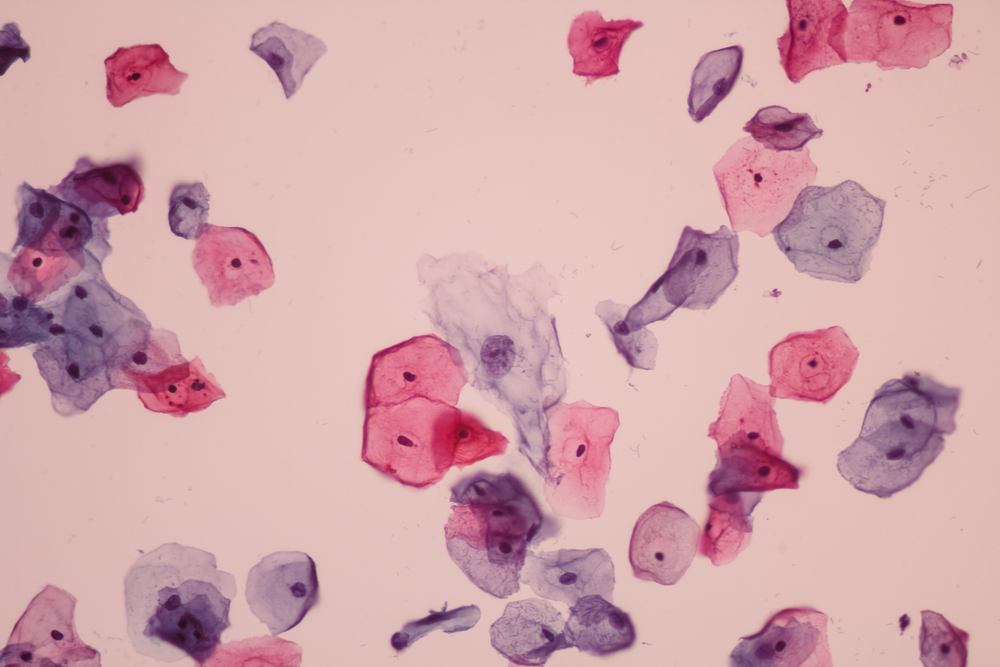According to GLOBOCAN database, the second most common cancer among Indian women is cervical cancer. Cervix is the lower portion or mouth of the uterus facing in the vagina.
 Cervical cancer is classified into two main types – the most common type (9 out of 10 cases) is squamous cell carcinoma which develops in the exocervix and has features of squamous cells when looked under a microscope, and adenocarcinomas that develop from the mucus-producing gland cells of the endocervix (a part of cervix that is closest to the body of uterus).
Cervical cancer is classified into two main types – the most common type (9 out of 10 cases) is squamous cell carcinoma which develops in the exocervix and has features of squamous cells when looked under a microscope, and adenocarcinomas that develop from the mucus-producing gland cells of the endocervix (a part of cervix that is closest to the body of uterus).
What are squamous cells?
Epithelium is a type of tissue that lines the outer surfaces of our body’s organs and inner surfaces of many internal organs. Epidermis, which is the outermost skin layer, is an example of epithelium.
Epithelial cells can be of three different shapes, namely, squamous, cuboidal and columnar. In simple epithelium, any one of these shapes of cells is arranged in a single layer while in the stratified epithelium, there are two or more layers of cells.
Epithelial cells make up all glands in the body. These cells perform many functions including protection, secretion, sensing, absorption and transportation between cells.
Squamous cells have a scale-like, flat appearance and their width is more than their height. The word “squamous” is derived from a Latin word ‘squama’ which means “fish or serpent scales.”
What is cervical cancer?
Cervical cancer begins in the cells that line the cervix, which is the lower portion of the uterus or womb in women. Measuring about 2 to 3 centimetres in length, the cervix connects the uterus to the birth canal or vagina. The region of cervix close to the uterus is known as endocervix while the part of cervix closest to the vagina is called ectocervix.
Cervical cancer is grouped into two types: squamous cell carcinoma and adenocarcinoma based on how the cancer cells look under a microscope.
Squamous cell carcinomas are the most common type of cervical cancer and account for 80 percent of cases. These cancers begin in the squamous cells that are thin and flat cells that line the cervix.
Adenocarcinomas are formed in the glandular cells which are found in the upper region of the cervix and account for 20 percent of cases.
Precancerous changes
The cervical cells do not change into cancer suddenly but instead first develop pre-cancerous changes. These changes gradually turn into cancer.
A Pap smear test is done to find out the exact nature of these pre-cancerous changes which are then described as cervical intraepithelial neoplasia (CIN) or squamous intraepithelial lesion (SIL).
Cervical intraepithelial neoplasia
Cervical intraepithelial neoplasia or CIN are abnormal cells that are found on the surface of the cervix. CIN indicates abnormal changes in squamous cells that line the cervix but is not cancer. It takes many years for these changes to turn into cancer and in many women, the abnormality resolves on its own.
CIN is classified into three grades that are based on how deeply these abnormal cells have penetrated the cervix lining.
- CIN2 is also called low grade squamous intraepithelial lesion where abnormal cells have entered one-third of the lining of the cervix. CIN1 is usually a reversible stage of infection of HPV (Human papillomavirus).
- CIN2 or high-grade squamous intraepithelial lesions is where abnormal cells are found in up to two-thirds of the lining of the cervix.
- CIN 2 or high-grade squamous intraepithelial lesions is when abnormal cells are found in the entire thickness of the lining of the cervix.
Risk factors of cervical cancer
Some possible risk factors of cervical cancer (SCC) include:
- Human Papillomavirus (HPV) infection that is untreated or is persistent
- Having multiple sexual partners
- Poor menstrual hygiene.
- Becoming sexually active at a young age
- Giving birth multiple times
- Smoking
- Conditions that lower immunity such as HIV, organ transplant or immunosuppressive drugs.
Having any one or more of the risk factors of cervical cancer does not mean that you will definitely get cervical cancer. Consulting a top oncologist in your area is the best way to understand if you are at risk for cervical cancer.
Symptoms of Cervical Squamous Cell Carcinoma
Early-stage cervical cancer or cervical intraepithelial neoplasia have no symptoms. Most women with cervical cancer do not experience any symptoms until the cancer spreads into the nearby tissue. At this stage, symptoms of cervical cancer (SCC) can include:
- Abnormal vaginal bleeding such as bleeding or spotting in-between periods, bleeding after vaginal sex, bleeding post-menopause, having heavier or longer periods.
- Unusual discharge that may contain blood from the vagina can occur after menopause or between periods.
- Pain during sex.
These symptoms can also be due to other conditions such as vaginal infection or hormonal imbalance. Your doctor will recommend the appropriate tests to find out the root cause of such symptoms.
Treatment options for Cervical Squamous Cell Carcinoma
Low-grade CIN usually resolves by itself and does not need treatment. Your doctor may recommend regular Pap smears to keep a check on the abnormal cells.
For high grade or severe CIN, treatment is focused on removing abnormal cells which can become cancerous.
Removal procedures include:
-
Loop electrosurgical excision procedure (LEEP)
In this procedure, an electrically charged wire is used to remove the abnormal tissue. Unlike ablation, LEEP removes tissue samples so that they can be analyzed through biopsy.
-
Cold knife cone biopsy
In this surgical procedure, a cone-shaped tissue with the lesion is removed and is used as a sample for further testing. Cone biopsy is usually an option for women who want to preserve their fertility.
-
Hysterectomy
This is an option when other procedures do not result in the removal of cancer. Hysterectomy involves the removal of the uterus and typically used for persistent CIN.
-
Radiation therapy
External beam radiation therapy is given to the pelvis along with brachytherapy (internal radiation) to destroy cancer cells. This is the preferred option for women who do not need to preserve their fertility.
-
Chemoradiation
As a standard treatment, chemotherapy drugs such as cisplatin are given along with radiation therapy for select cases when radiation is done as a primary mode of treatment.
-
Targeted therapy
Targeted drugs specifically target certain factors which enable cancer cells to grow. Pazopanib is a targeted drug that has been shown to be beneficial in clinical trials.
For women who develop malignant features in the cervix, the treatment options include surgery (for very early stage cancer) or radiation with concurrent chemotherapy (for later stages) depending on the stage of the disease.
Cervical squamous cell carcinoma is treatable when detected early. Consult a top oncologist in your area to know about screening tests, risk factors and treatment options for cervical cancer (squamous cell carcinoma).



